So You Loved Spider-Man: Homecoming? Read These Comics Next
From Tom Holland & Michael Keaton to Brian Michael Bendis & Hannah Blumenreich
Main Art by Hannah Blumenreich Comics Lists spider-man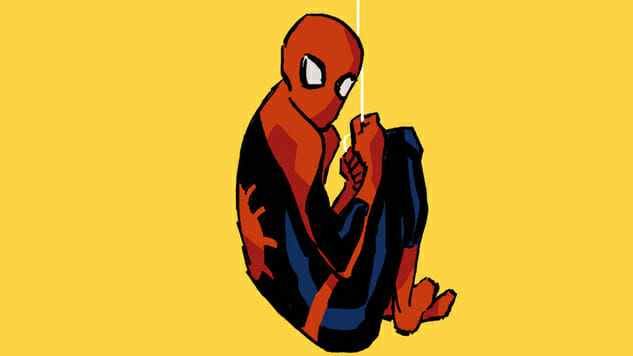
Spider-Man: Homecoming swung into theaters this past weekend and the response has been near-unanimous: despite five previous films across two now-defunct continuities, this is Spider-Man. Thanks to a strong cast full of standout performances (Zendaya!), perfect casting in the form of Tom Holland and Michael Keaton and a seamless assimilation into the Marvel Cinematic Universe, Homecoming stands out not just as a superior wallcrawler film, but as a highlight of the MCU’s ever-expanding bounty of film outings. Diving into Peter Parker’s comic history can be a daunting task, though: nearly every era has standout stories, and Parker’s exploits are among Marvel’s most frequently double- and triple-shipped comics, adding up to over 700 issues of his main series, let alone long-running titles like Ultimate Spider-Man. The webheads here at Paste took a crack at narrowing down 10 suggested stories for fans of Homecoming, although we could just as easily have suggested the near-entirety of the aforementioned Ultimate Spider-Man, which served as a major inspiration on Homecoming’s high-school setting. There are major Spidey touchstones missing from this list—”The Death of Jean DeWolff” and “The Kid Who Collects Spider-Man,” sob—but we curated with an eye toward accessibility and matching the magic that made Homecoming work so well. Be sure to let us know on Twitter if we missed any essential arachnid tales.
 “If This Be My Destiny,” The Amazing Spider-Man
“If This Be My Destiny,” The Amazing Spider-Man
Writers: Stan Lee, Steve Ditko
Artist: Steve Ditko
Spider-Man co-creator Steve Ditko immortalized the soul of his landmark superhero through this powerful cover released in February 1966. This image is Spider-Man. The concluding chapter of the three-issue “If This Be My Destiny” arc trapped Peter Parker in a flooded underwater hideout, a latticework of steel pinning him down as he loses consciousness. The image immaculately captures an underdog icon struggling to uphold the weight of the world on his back—guilt, responsibility and teenage hormones substantiated into a collapsing industrial clusterfuck. (And Homecoming director Jon Watts evidently felt the same way, given the film’s direct homage.) Stan Lee and Ditko’s narrative also provides a thematic bookend to the character’s first appearance in Amazing Fantasy #15, with Parker striving to cure his Aunt May of radioactive poisoning. With the ghostly words of Uncle Ben haunting him, Spidey infiltrates Doctor Octopus’ lair, kicks some ass and embraces his inner Atlas to deliver a remedy to Dr. Kurt Conners—saving his last family member and staving off the Parker curse. Stirring story aside, this imagery serves as some of the most iconic eye candy for the superhero genre, and a bittersweet reminder of how relatively short and sweet Ditko’s contribution to the medium was. Sean Edgar
 “Kraven’s Last Hunt,” The Amazing Spider-Man, Web of Spider-Man, The Spectacular Spider-Man
“Kraven’s Last Hunt,” The Amazing Spider-Man, Web of Spider-Man, The Spectacular Spider-Man
Writers: J.M. DeMatteis, Peter David, David Michelinie, James Owsley
Artists: Mike Zeck, Mark Beachum, Mark Bright, Steve Geiger, John Romita, Jr.
The grim comics era ignited by Watchmen and The Dark Knight Returns stained Peter Parker’s vibrant myth in this 1987 arc helmed by J.M. DeMatteis. It’s also a cutting character dissection of the men and women who put on ridiculous costumes to reign terror on the public. The six-issue story ran through all three of Spider-Man’s ongoing titles at the time, and starred the Russian hunter Kraven tranquilizing Spidey, burying him alive and impersonating the hero for the remainder of the tale. And he’s pretty good—if brutally efficient—at the job, taking down foes with ease that Peter Parker struggled to defeat. This story occupies a slot in the webbed archives, though, because of its harrowing ending, which witnesses Kraven ending his life after achieving a sense of accomplishment from conquering his foe through subversively patronizing methods. That finale invited a bizarre cognitive dissonance uncommon for the happy endings that frequent most superhero yarns. Do most villains suffer from superhero envy? Should they be given hugs instead of concussions? And damn, Marvel, suicide via shotgun for a character created by Lee and Ditko in ’64—only two years into the Spider-Mythos? And how does that tragic belittling affect the psyche of a hero constantly doubting his self-worth? Never answered, these questions still surround this haunting outlier. Sean Edgar
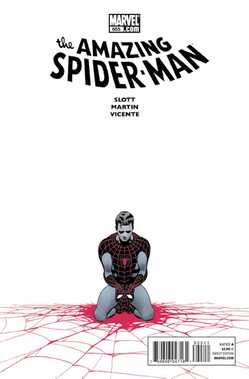 “No One Dies,” The Amazing Spider-Man
“No One Dies,” The Amazing Spider-Man
Writer: Dan Slott
Artist: Marcos Martin
Spoiler alert, but Homecoming wisely opts to avoid hampering Tom Holland’s first full Spider-Man outing with any character deaths—no Uncle Ben redux, no love interest gone before her time, no ally caught in the crossfire. While it was a welcome break from the pathos of previous films, tragedy is a core component of the character, shaped as he is around the preventable death of a loved one. In this two-issue arc, the murder of longtime supporting character J. Jonah Jameson’s wife, Marla, prompts a nightmare in which Peter confronts everyone who has died “on his watch,” from Gwen Stacy to more easily forgotten characters like Frederick Foswell, in a stunning sequence illustrated by Private Eye’s Marcos Martin. Longtime Amazing Spider-Man writer Dan Slott uses this opportunity to double down on the sense of responsibility—and guilt—that drives Parker to continue his heroic tenure, but it’s Martin’s emotional dreamscapes that make this such a gorgeous example of the tragedy behind Spider-Man. Steve Foxe
 “Power and Responsibility,” Ultimate Spider-Man
“Power and Responsibility,” Ultimate Spider-Man
Writer: Brian Michael Bendis
Artist: Mark Bagley
Brian Michael Bendis and Mark Bagley ushered Spidey into the 21st century with a new comic that could have cared less about acrobatics and fisticuffs. Bendis had cleaved an indie path with dialogue-driven noir in such works as Torso, Fire and Goldfish throughout the late ‘90s, and that surgical focus on character and words—largely influenced by the film scripts of David Mamet—translates beautifully here, with Peter Parker refusing to don his webbed leotard until the tail end of the third issue. “Power and Responsibility” is a gorgeously accessible and passionate introduction to the character, the debut of Marvel’s Ultimate Universe designed to retell classic origin stories in a modern context. Veteran Spidey artist Bagley injects kinetic ‘90s verve with some stirringly emotional moments in these seven issues, including a heartbreaking panel of Peter Parker and Mary Jane embracing in the wake of Uncle Ben’s death. The result embraces the universal truth that high school is hell and even male power fantasies come with caveats. The ensuing 11 years and 200 issues of the title would yield some of the most refreshing and resonant superhero comics in years. Sean Edgar
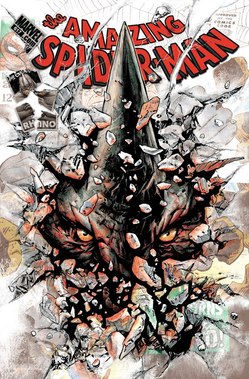 “Rage of the Rhino”/“Endangered Species,” The Amazing Spider-Man
“Rage of the Rhino”/“Endangered Species,” The Amazing Spider-Man
Writer: Joe Kelly
Artist: Max Fiumara
Following the controversial undoing of Peter Parker’s marriage to Mary Jane Watson, Amazing Spider-Man underwent a creative revival, shipping thrice-monthly with rotating creative teams. While the initial focus was on creating new villains (few of which have stuck, save perhaps Mister Negative), the over-arching “The Gauntlet” saga reintroduced Spidey’s classic rogues in major fashion. As Homecoming proves with Michael Keaton’s engrossing portrayal of the Vulture, none of Spider-Man’s often-animal-themed villains are inherently uninteresting, and the connected stories “Rage of the Rhino” and “Endangered Species” showcase the emotional capacity of even the most seemingly straightforward foe. The Rhino, like most great rogues, is a sympathetic figure, and in this tale suffers a personal loss that pushes him past his breaking point. Joe Kelly, who also authored this era’s hilarious Deadpool team-up, mines surprising depth from the Rhino’s attempt to lead a better life, and frequent Mignolaverse contributor Max Fiumara lends his angular, off-kilter style to Rhino’s rampages and Spidey’s leaps and bounds alike. The Vulture may not have a grand comic saga of his own, but these Rhino tales are a good example of Spidey’s foes owning their own stories. Steve Foxe
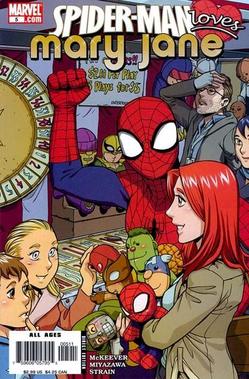 Spider-Man Loves Mary Jane
Spider-Man Loves Mary Jane
Writer: Sean McKeever
Artist: Takeshi Miyazawa
I could write about Sean McKeever and Takeshi Miyazawa’s Spider-Man Loves Mary Jane at least once a year, and I probably do. From 2005 to 2007, they put out 20 issues (David Hahn took over interior art from issues 16 to 20) of sweet, smart stories focused not on Spidey, but on his long-term love interest. Even when writers try to make Mary Jane Watson interesting, they tend to fail because they still treat her as an accessory. McKeever’s innovation was in hardly including Spider-Man at all, recognizing that Mary Jane’s own everyday high-school life was more than enough to serve as the focus of a book. The plot summaries don’t sell it, but if you know McKeever’s writing (he’s written for other Spider-Man books, too, as well as a great Teen Titans run and some X-Men titles), you know how good he is at spinning out a story. Miyazawa’s art has a manga-type look without going full-on big eyes, and it fits the title perfectly. Consider it an alternate universe or dismiss it as a comic for girls, but if you don’t read it, you’re really missing out. Hillary Brown
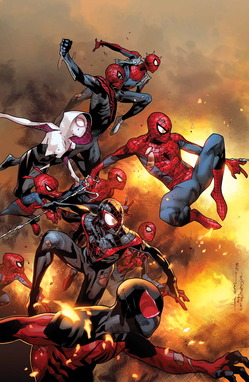 “Spider-Verse,” The Amazing Spider-Man
“Spider-Verse,” The Amazing Spider-Man
Writer: Dan Slott
Artists: Olivier Coipel, Guiseppe Camuncoli, Others
No one in their right mind could reasonably call the “Spider-Verse” accessible—it spins out of the era in which Otto Octavius’ mind was in Peter Parker’s body, and tied up long-dangling threads surrounding Morlun and the “Spider-Totem” concept introduced over a decade ago. Yet this multiversal showdown is, at its heart, a love song to Peter Parker’s enduring appeal and the wide world of webslingers, incorporating iterations ranging from the futuristic (Spider-Man 2099) to the porcine (Spider-Ham), as well as strong fellow Spider-folk like Spider-Woman, Silk and Spider-Gwen. Filmgoers are no strangers to conflicting Parker chronologies, having lived through three modern versions of cinematic portrayals, and so the pitch that “Spider-Verse” contains (nearly) every Spider-Man ever may not be a deterrent, especially coupled with Olivier Coipel’s stunning linework and Dan Slott’s reliable grasp on the character. Steve Foxe
 Spidey Zine
Spidey Zine
Writer/Artist: Hannah Blumenreich
Publisher: Self-Published
A few years ago, Hannah Blumenreich made a little zine focused on Spider-Man, which became so popular she ended up doing actual Spidey work for Marvel. Unburdened by decades of mythology or audience demands, her Spidey Zine is a low-key, entertaining addition to the Spiderverse. Instead of the usual “hello, fellow teens” approach that tends to characterize the work of older writers, her Spidey inhabits his age and nerdiness as comfortably as his Spider-suit. He bitches about Gilmore Girls and would generally rather spend time on the couch than going out with Mary Jane. Blumenreich gets a lot into a few pages. Most of her story arcs don’t take up more than a page or two. Some are black and white, some duotone and some full color, demonstrating a range of visual styles and storytelling techniques, but all have an appealing slouchiness. You could call it rumpled minimalism and that description would be accurate. Some fan art is cringeworthy in its wide-eyed hero worship, but this stuff is great, rendered with a sharpness of line and narrative that gets in, makes its point and gets out fast, leaving you wanting more. Hillary Brown
 Ultimate Comics: Spider-Man #1-#12
Ultimate Comics: Spider-Man #1-#12
Writer: Brian Michael Bendis
Artists: Sara Pichelli, David Marquez, Chris Samnee
If you’ve seen Homecoming, you may have noticed the brief shout-out (“I’ve got a nephew…”) to Miles Morales, the second Ultimate Spider-Man and the current adjective-less Spider-Man in the main Marvel Universe. If you’ve read Miles’ stories, you know that the film’s version of Peter Parker and his supporting cast takes a good deal of inspiration from Miles’ characterization as a young teen navigating girls, seeking mentorship from older heroes and palling around with a LEGO-obsessed Asian-American bff who quickly discovers his secret identity. That said, Miles is his own character, and the first 12 issues of his inaugural solo series, before it gets embroiled in a crossover, are among the most compelling arachnid-powered adventures in the history of the character’s legacy, illustrated with aplomb by Sara Pichelli and David Marquez (with a great guest issue from Chris Samnee). Brian Michael Bendis captures lightning in a bottle a second time by subverting well-known Spider-tropes—like the inspirational uncle—and introducing brand-new wrinkles, like his often-revealed identity and a host of Spider-powers Peter Parker could only dream of having at his disposal. If you dig these relatively self-contained issues, it’s worth powering through the crossovers to see Pichelli’s terrifying rendition of Venom, watch Miles pal up with the All-New Ultimates and eventually join the Avengers and the Marvel Universe and continue the tradition of high-school-set Spider-shenanigans, even as Peter Parker becomes a globetrotting super-scientist. Steve Foxe
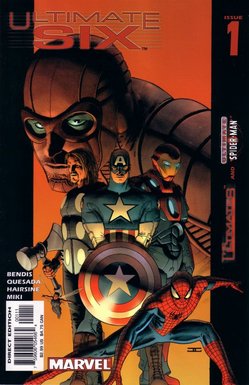 Ultimate Six
Ultimate Six
Writer: Brian Michael Bendis
Artist: Trevor Hairsine
Ultimate Spider-Man pioneer Brian Michael Bendis and artist Trevor Hairsine previewed the shared cinematic Marvel Universe more than a decade before Tom Holland would join Robert Downey Jr. in Captain America: Civil War. Instead of relying on hero-vs.-hero action, though, these scripts unite Spidey’s rogues gallery of Electro, Kraven the Hunter, the Sandman, Doctor Octopus and Green Goblin (we’ll keep the sixth member a secret) into an unsettling reflection on terrorism. In the seven-issue event, Nick Fury engulfs a young Peter Parker into a bureaucracy of political post-militarism as the teenage Parker grapples with a handful of batshit-dangerous criminals targeting his family. Hairsine shifts the tone to a harsher, photo-realistic rendering suited to the utilitarian, stainless-steel environs. But the standout visual from this under-the-radar gem features Doctor Octopus telepathically guiding his detached tentacles through a prison in one of the coolest and bloodiest breakouts in Marvel history. Sean Edgar